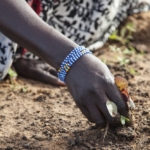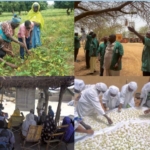


l'Institut d'Economie Rurale
Mali
8/2018—8/2022
This project focuses on improving the livelihoods of smallholder farmers in the Sikasso, Koulikoro, and Kayes regions of Mali through the cultivation and use of micronutrient dense and high-yielding dual-purpose sorghum and cowpea genotypes,improved animal nutrition,improved soil fertilityand crop management options and environment protection strategies. A participatory approach will be used to evaluate about fifty dual-purpose, micro-nutrient dense sorghum genotypes in collaboration with farmersin different agro-physical contexts. The dual-purpose sorghum genotypes selected by the producers (men and women),according to their own criteria, will be integrated into sorghum and cowpea intercropping systems for increased productivity. Also, the selected well-performing sorghum genotypes will be used to develop micro-nutrient dense hybrids. New nutritious food products based on the micro-nutrient-rich sorghum flours will be created, to reinforce market opportunities for the farmer-selected varieties and foster nutritional outcomes. The breeding methodology will be refined bysystematically testing farmers’ preferred sorghum and cowpea genotypes for intercropping ability. Improved crop productivity will be achieved through the combined use of organic manure and minimal use of chemical inputsand plants/botanical pesticides. Improved livestock feeding options, combining dual-purpose sorghum stover and cowpea haulms will be evaluated with producers in different socio-economic contexts. The dual purpose sorghum genotypes and cowpea and the agronomic practices preferred by the producers for various reasons (increased productivity, quality and profitability, risk reduction)during Phase I will serve as a basis for this study. The proposed implementation plan will use participatory monitoring and evaluation tools integrating all stakeholders to appreciate progress on the theory of change. Monitoring and evaluation will be carried out periodically to evaluate, profitability, feasibility, risk, adoption and perception of farmers on new technologies. Capacity building for phase II will include both degree trainings for students and capacity strengthening of farmers and their organizations on specific sorghum/cowpea production topics, human and animal nutrition as well as income generation technologies. Thus, training of young scientists across different disciplines will reinforce national research capabilities. The capacity building of farmers will improve their knowledge on new technologies needed to increase smallholder farmer’s income. The implementation plan will build on on-farm and on-station activities, strong partnership with farmers’ organizations, extension agencies and research institutions. The implementation of the project will increase productivity, improve the human and animal nutrition of smallholders through the adoption of micronutrient-dense, dual purpose genotypes. Soil fertility will be improved through the associationof cereal with legume crops (sorghum and cowpea) and also by the application of organic manure. The use of botanical pesticides for pest and disease control in the sorghum / cowpea system will reduce the use of external chemical inputs. These options will reduce the overall use of chemicals inputs in the cropping systems and thus, protect the environment.
The overall objective of the ‘Dual-Purpose Sorghum and Cowpeas – Phase II’ project is tooffer a set of opportunities and technologies to sustainably intensify crop and livestockproduction for improved income and nutrition through the development and dissemination ofdual-purpose sorghum and cowpea varieties. The project seeks to achieve the following specific objectives:Objective 1: Enhance availability of micronutrient-dense dual-purpose sorghum varietiesand hybrids to improve smallholder farmers’ production and nutrition Objective 2: Improve dual-purpose sorghum and cowpea production through the use ofagro-ecological intensification options Objective 3: Improve crop and livestock integration through the use of dual purposesorghum and cowpea residues to feed the livestock, and livestock manure to feed the soil Objective 4: Assess farmer’s perception, profitability and risks of the use of dual purposesorghum and cowpea based technologies through monitoring and evaluation Objective 5: Strengthen the capacity of young scientists (MSc and PhD) in crop-livestockintegration research and strengthen the capacity of famers to better integrate crop-livestockproduction options within their farming systems.


